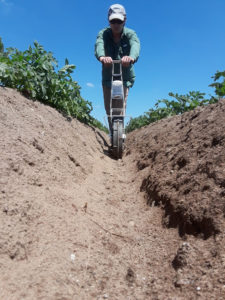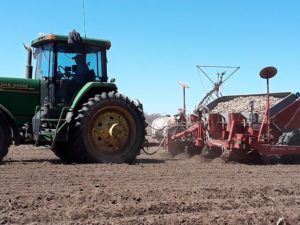Fried, baked or mashed, we love our potatoes. What we don’t love is drinking water with lots of nitrate — a form of nitrogen that fuels a robust potato crop because it acts as a fertilizer. In the Central Sands area of the state, which is where most spuds are grown, drinking water is groundwater and groundwater can bear the brunt of unwelcome potato cultivation effects.
“When you look at impacts on the groundwater system from typical cropping systems in the Central Sands, they tend to leach nitrate,” said Kevin Masarik. “Potatoes are particularly challenging because the hill and furrow system tends to promote both (water) recharge, as well as nitrate leaching loss due to the high nitrogen demand of that particular crop.”
Although he’s not armed with regulatory suggestions — or even salt, butter and sour cream — Masarik is coming for those potatoes. The researcher from the University of Wisconsin-Stevens Point and University of Wisconsin-Madison Division of Extension is armed with a one-row hand planter, and rye, millet and oat seeds. He’s got in mind science-based solutions, not potato-growing restrictions or even gastronomical intentions.

With two years of funding from the University of Wisconsin Water Resources Institute, he’s pursuing what he termed an outside-the-box idea for assessing whether this tasty tuber can be cultivated in a way that reduces the movement of nitrite into the groundwater.
In children six months and younger, nitrate promotes the oxidation of hemoglobin to methemoglobin that limits blood’s ability to bind and transport oxygen, depriving the infant of oxygen. Nitrate has also been linked to cancer, thyroid disorders, birth defects and hypertension. Both state health and agricultural officials name nitrate as the most widespread groundwater contaminant in Wisconsin affecting both municipal and private water systems. Because groundwater also makes its way to surface waters, rivers, lakes, streams and wetlands can see higher nitrate levels with one result being increased algae growth, disrupting ecosystems.
Masarik said for the last 20 or 30 years, when the cause and extent of nitrate in groundwater has been documented, there’s been a simultaneous gap. “We’ve been good at pointing out that there’s a problem, but we haven’t been good at pointing out what the solution is.”
He continued, “In the last five years, I’ve been trying to switch the questions that I’m interested in devoting my time and attention to, investigating potential solutions that significantly improve water quality. And that’s what this project was born out of.”
“Investigating in-season cover crops for reducing nitrate loss to groundwater below potatoes” is an aptly descriptive title of what the project is doing: interseeding cover crops — the rye, millet and oats — among potato rows to see if these added plants will take up the excess nitrate and thereby improve water quality.
Critically, the project also needs to ensure that the potato harvest isn’t hindered nor yield significantly reduced by the additional vegetation between rows.

Masarik is grateful for the cooperation of Portage County farmer Justin Isherwood who in 2020 provided a test plot. “It’s (the study) giving me the book,” Isherwood said. “We know a lot of things in agriculture. There are a few things in agriculture we don’t know. Kevin is giving me those letters and the alphabet. He’s giving me the language of the landscape.”
Isherwood is game to again participate in the study this year. “It’s exciting to be a part of the science and to be involved in the discovery.”
Discoveries of last year will be applied. For example, rye is likely to be removed from the seed mix because it put early energy into root growth, resulting in slow above-ground growth. The rye was then shaded out by potato plants. Other plants, though, “Did have some success. I think it showed that the amount of biomass accumulation and the amount of nitrogen that the interplanting, or that cover crop, was able to capture is significant enough that this could be viable,” Masarik said, as enthusiasm bubbled. He said he is energized for the coming growing season. “I enjoy talking about it. I’m pretty excited about it.”
Masarik also wanted to talk about potato growers, who he termed as wanting to be proactive on the nitrate-loading challenge. “It’s all about establishing the plots and making sure that biomass we’re able to grow in that space is successful. If it’s successful, then what is the impact on the actual crop itself. If the impact isn’t too great, it might be a viable strategy. It might not be something that growers would naturally want to do. I think they are looking for solutions.”

This project is also about building blocks. To gauge the effectiveness of this approach on water quality, it builds on Masarik’s earlier refinement of methods to track groundwater quality by drawing samples from temporary wells dug with a bucket auger to sample the top of the water table. This establishes a baseline, then he returns in 12 months, repeating the process to check what effect the interseeding might have on groundwater quality. The goal is determining a statistically significant difference that he pegged at minimum of 20% of change.
A second and future building block is if this effort, which Masarik called a proof of concept, is successful it can be used with other crops to reduce nitrate leaching in those fields.
The post Experimental cultivation method could mean healthy potato yield and healthier water first appeared on WRI.
News Release – WRI
https://www.wri.wisc.edu/news/experimental-cultivation-method-could-mean-healthy-potato-yield-and-healthier-water/
